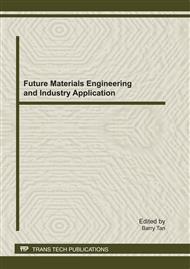[1]
G. M. Ritcey; A. W. Ashbrook. Solvent Extraction—Principles and Applications to Process Metallurgy, Part I, Elsevier, 1984, 21–26.
Google Scholar
[2]
G. M. Ritcey; A. W. Ashbrook. Solvent Extraction—Principles and Applications to Process Metallurgy, Part II, Elsevier, 1979, 78–99.
Google Scholar
[3]
Young Jun Park, Derek J. Fray. Recovery of high purity precious metals from printed circuit boards, Journal of Hazardous Materials, vol. 164, 2009, pp.1152-1158.
DOI: 10.1016/j.jhazmat.2008.09.043
Google Scholar
[4]
Papadopoulos, A. Fatta, D. Parperis, K, Mentzis, A. Haralambous. Nickel uptake from a wastewater stream produced in a metal finishing industry by combination of ion-exchange and precipitation methods, Sep. Purif. Technol. vol. 39, 2004, pp.181-188.
DOI: 10.1016/j.seppur.2003.10.010
Google Scholar
[5]
H. Fauve-Buresi. Challenging year for the ICT industry for WEEE and RoHS, in: Proceedings of the 5th International Electronics Recycling Congress, Hamburg, Germany, (2006).
Google Scholar
[6]
B. Ramachandra Reddy, D. Neela Priya. Process development for the separation of copper(II), nickel(II) and zinc(II) from sulphate solutions by solvent extraction using LIX 84 I., Sep. Purif. Technol. vol. 45 , 2005, p.163–167.
DOI: 10.1016/j.seppur.2005.02.014
Google Scholar
[7]
W.J. Hall; P.T. Williams. Separation and recovery of materials from scrap printed circuit boards, Resour. Conserv. Recycl. Vol. 51 , 2007, pp.691-709.
DOI: 10.1016/j.resconrec.2006.11.010
Google Scholar
[8]
Henkel. Minerals Industry Division Red Book, Chemistry of Metals Recovery Using LIX Reagents, Publisher, (1989).
Google Scholar
[9]
LAN Zhuo-yue; HU Yue-hua; LIU Jian-she. Solvent extraction of copper and zinc from bioleaching solutions with LIX984 and D2EHPA, J. CENT. SOUTH UNIV. TECHNOL. vol 12(1), 2005, pp.46-52.
DOI: 10.1007/s11771-005-0201-z
Google Scholar
[10]
S. Panigrahi; P.K. Parhi; K. Sarangi. A study on extraction of copper using LIX84-I and LIX 622N, Sep. Purif. Technol, vol. 70, 2009, pp.58-61.
DOI: 10.1016/j.seppur.2009.08.013
Google Scholar
[11]
J. Wang, Z. -J. Zhang, Z. -F. Zhang, M. Qaisar, P. Zheng. Production and application of anaerobic granular sludge produced by landfill,,J. Environ. vol. 19, 2009, p.1454–1460.
DOI: 10.1016/s1001-0742(07)60237-x
Google Scholar
[12]
George Owusu. Selective extraction of copper from from acidic zinc sulfate leach solution using LIX622, Hydrometallurgy, vol. 51, 1999, pp.1-6.
DOI: 10.1016/s0304-386x(98)00062-0
Google Scholar
[13]
A.M. Sastre; F.J. Alguacil. Co-extraction and selective stripping of copper(Ⅱ) and molybdenum(Ⅵ) using LIX 622, Chemical Engineering Journal. Vol. 81, 2001, pp, 109-113.
DOI: 10.1016/s1385-8947(00)00237-0
Google Scholar
[14]
A. Ocio M.P. Elizalde. Correlation of the extraction constant values of Cu(Ⅱ) by 5-dodecylsalicylaldoxime from phosphoric acid media, Fluid Phase Equilibria. Vol. 284, 2009, pp, 144-151.
DOI: 10.1016/j.fluid.2009.07.012
Google Scholar
[15]
Md Fazlul Bari; Md Sohrab Hossain; Iqbal M. Simultaneous extraction and separation of Cu(Ⅱ), Zn(Ⅱ), Fe(Ⅱ) and Ni(Ⅱ) by polystyrene microcapsules coated with Cyanex272, Hydrometallurgy, vol. 95, 2009, pp.308-312.
DOI: 10.1016/j.hydromet.2008.07.003
Google Scholar
[16]
A.A. Nayl. Extraction and separation of Co(Ⅱ) and Ni(Ⅱ) from acidic sulfate solutions using Aliquat 336, Journal of Hazardous Materials, vol. 173, 2010, pp.223-229.
DOI: 10.1016/j.jhazmat.2009.08.072
Google Scholar
[17]
N.A. Sayar; M. Filiz; A.A. Sayar. Extraction of Co(Ⅱ) and Ni(Ⅱ) from concentrated HCl solution using Alamine 336, Hydrometallurgy, vol. 96, 2009, pp.148-152.
DOI: 10.1016/j.hydromet.2008.09.005
Google Scholar
[18]
A. Ocio; M.P. Elizalde. Correlation of the extraction constant values of Cu(Ⅱ) by 5-dodecylsalicylaldoxime from phosphoric acid media, Fluid Phase Equilibria. Vol. 284, 2009, pp.144-149.
DOI: 10.1016/j.fluid.2009.07.012
Google Scholar
[19]
LAN Zhuo-yue, HU Yue-hua, L IU Jian-she. Solvent extraction of copper and zinc from bioleaching solutions with L IX984 and D2EHPA, J. CENT. SOUTH UNIV. TECHNOL. Vol. 12(1), 2005, pp.46-51.
DOI: 10.1007/s11771-005-0201-z
Google Scholar
[20]
LIU Xiao-rong, QIU Guan-zhou, HU Yue-hua Effect of Lix984N content on phase disengagement dynamics in copper-SX, Trans. Nonferrous Met. Soc. Vol. 13(4), 2003, pp.963-969.
Google Scholar


